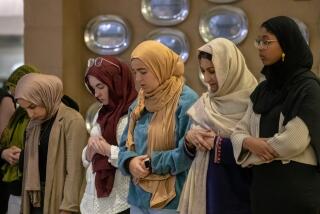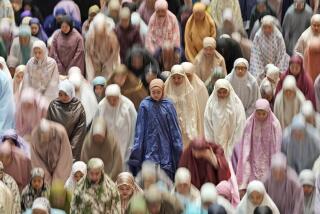Islamic Life, Activism Booming in U.S., Study Finds
- Share via
Islamic religious life in America is booming, registering a 300% increase in the number of followers flocking to mosques in the last six years and an outpouring of community activism, according to a comprehensive national study of American Muslims released Thursday.
The Mosque Study Project, part of a larger study of American congregations coordinated by Hartford Seminary, found that 2 million Muslims attend 1,209 mosques nationwide. The number of mosques grew 25% since 1996.
For the record:
12:00 a.m. April 28, 2001 For the Record
Los Angeles Times Saturday April 28, 2001 Home Edition Metro Part B Page 4 Metro Desk 1 inches; 27 words Type of Material: Correction
New mosque--A story in Friday’s Times about a boom in Islamic religious life erroneously reported that a new mosque was built in Century City a few years ago. It was constructed in Culver City.
More than two-thirds of these worshipers were actively engaged in the broader community through involvement with interfaith dialogues, presentations of Islam to schools and churches and dealings with political leaders and the media.
That finding surprised the authors, who expected a greater number “would be focused internally and uninterested in the world outside,” said Ihsan Bagby, the study’s lead researcher and a professor of international studies at Shaw University in Raleigh, N.C. “Mosques are becoming the springboard for Muslim involvement in America,” he said.
The Islamic boom is evident in Southern California, where at least seven major new mosques have been built in the last few years in Mission Viejo, Rancho Cucamonga, Pomona, Irvine, Cypress and Century City. Several other Islamic centers are significantly expanding their facilities in Orange County, the South Bay and the Inland Empire.
Hussam Ayloush of the Council of American-Islamic Relations said the burgeoning numbers are in part prompted by a religious renaissance among Muslims. As Muslims gain confidence and acceptance here, he said, more feel comfortable enough to begin practicing their religion overtly.
One distinctive change, Ayloush noted, was the growing numbers of employers who now allow their Muslim employees to leave work for Friday prayer. When he began work with the Islamic council in 1997, he said he would get dozens of complaints a week about the issue, but such calls have dwindled to one or two.
As Muslim Americans continue to raise their religious profile, they are reaching out to serve the broader community, the study found. In Southern California, the trend is evidenced by such places as the Omar Ibn Al Khattab Foundation near USC, which is developing a seven-story learning center for art, science and technology to provide adult education, after-school care and tutoring for local residents. Plans for an extensive Islamic library and art gallery are also underway.
Since its establishment in 1984, the foundation has sponsored workshops on Islam for Los Angeles teachers, political candidate forums, and exhibits ranging from Islamic calligraphy to the Balkans war.
“We are still reaching for maturity and finding our own feet,” said Dafer Dakhil of the foundation, which opened the green-domed Masjid Omar in 1994. “But we are trying to contribute and become part of the mainstream.”
At the Islamic Center of Corona/Norco, membership has grown from 25 in 1990 to 200 today, said Kalim Farooki of the center. The group began with an insular focus but began cultivating relations with other faith groups, political leaders and media representatives when it first launched plans to build a mosque in 1993.
The groundwork paid off: The City Council unanimously approved a mosque use permit this month, overturning an initial denial by the Planning Commission. Among the things that made a difference, Farooki said, were community open houses to demystify Islam and show that Muslims also revere Abraham, Moses, Jesus and other figures from Judaism and Christianity.
The Muslim portion of the Hartford study was sponsored by the American-Islamic council, Islamic Society of North America, the Ministry of Imam W.D. Mohammad and Islamic Circle of North America. The study conducted interviews with representatives of 416 of the 1,209 mosques it identified.
The study found that average attendance at Friday prayer rose by 94% in six years. There were fewer mosques in the West than other parts of the country. South Asians--most prominently Indians and Pakistanis--comprised 33% of regular mosque participants, the largest group, followed by African Americans, then Arabs.
The study did not resolve the highly debated question of the size of the American Muslim population. Although the study says that a figure of 6 million to 7 million was “reasonable” based on the reported figure of 2 million associating with a mosque, Bagby acknowledged that assertion was based on “guesswork.”
Los Angeles demographer Pini Herman cautioned that self-reported attendance figures tend to be exaggerated. In one 1983 study of Israelis in Los Angeles, he said, community estimates were as high as 300,000 but he counted fewer than 12,000.
“It’s a rule of thumb that people exaggerate their numbers by a factor of two to 10,” said Herman, whose firm, Phillips & Herman Demographic Research, specializes in ethnic population studies.
More to Read
Sign up for Essential California
The most important California stories and recommendations in your inbox every morning.
You may occasionally receive promotional content from the Los Angeles Times.














